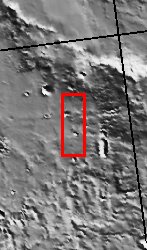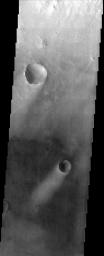
Released 17 September 2003
Bright wind streaks are present in the lee of craters and other obstacles in this image, located in Sinus Sabaeus, near the Martian equator. These streaks indicate that the local winds blow from the northeast (upper right in the image). The brightness of the streaks indicates that either bright material has been deposited in the lee of the craters, or that the surface has eroded preferentially in the lee of craters, exposing an underlying bright material. Because the streaks are bright regardless of the surrounding surface brightness, the first hypothesis most likely. The streaks probably all represent deposits of the same bright material that settled out of the atmosphere in the wind shelter provided by topographic peaks.
Image information: VIS instrument. Latitude -6.3, Longitude 14.1 East (345.9 West). 19 meter/pixel resolution.
Note: this THEMIS visual image has not been radiometrically nor geometrically calibrated for this preliminary release. An empirical correction has been performed to remove instrumental effects. A linear shift has been applied in the cross-track and down-track direction to approximate spacecraft and planetary motion. Fully calibrated and geometrically projected images will be released through the Planetary Data System in accordance with Project policies at a later time.
NASA's Jet Propulsion Laboratory manages the 2001 Mars Odyssey mission for NASA's Office of Space Science, Washington, D.C. The Thermal Emission Imaging System (THEMIS) was developed by Arizona State University, Tempe, in collaboration with Raytheon Santa Barbara Remote Sensing. The THEMIS investigation is led by Dr. Philip Christensen at Arizona State University. Lockheed Martin Astronautics, Denver, is the prime contractor for the Odyssey project, and developed and built the orbiter. Mission operations are conducted jointly from Lockheed Martin and from JPL, a division of the California Institute of Technology in Pasadena.

 Planetary Data System
Planetary Data System













